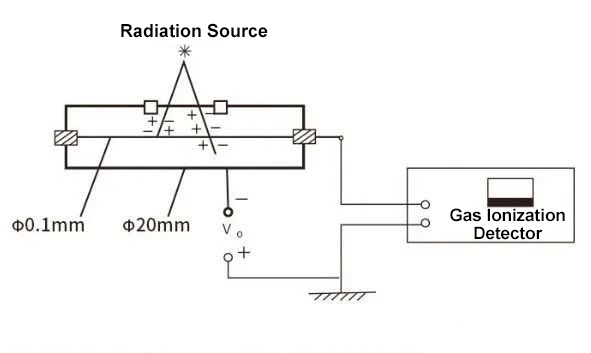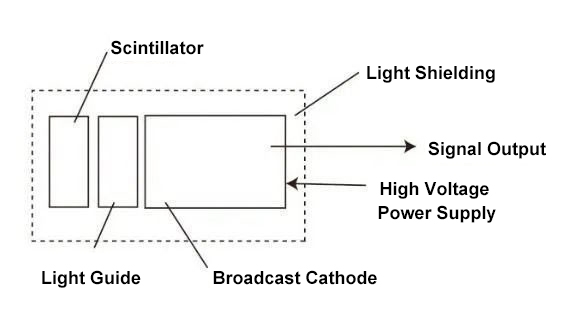A nuclear radiation detector, also known as a nuclear radiation detection instrument or radiation measurement instrument, is a device used to detect and measure ionic radiation such as alpha particles, beta particles, gamma rays, and neutrons. These nuclear radiation detectors play an important role in a variety of fields, including nuclear energy, medical diagnosis and treatment, radiation monitoring, nuclear science research, and nuclear security. sisco online shop will go into detail about the different types of nuclear radiation detectors.
The way nuclear radiation detectors give information is divided into two main categories: One is that particles are incident on the nuclear radiation detector and then undergo certain dispositions before they give information that is acceptable to people's senses. For example, a variety of particle track detectors, generally through the process of photography, development, or chemical corrosion. There are pyroelectric detectors, photoluminescent detectors, and thermal or optical excitation to give the light output related to the amount of irradiation. This class of detectors is largely outside the scope of nuclear electronics. Another type of nuclear radiation detector receives the incident particles, and immediately gives the corresponding electrical signal, after the electronic circuit amplification, and processing, can be recorded and analyzed. This second category can be called electrical detectors.
Gas Ionization Detector
The gas ionization detector is the earliest development of a nuclear radiation detector. When incident-charged particles pass through a gas, the gas molecules or atoms are ionized or excited, generating large star pairs of electrons and positive ions in their path. Gas ionization nuclear radiation detectors measure nuclear radiation by collecting the ionizing charges generated. There are many types of gas ionization nuclear radiation detectors, and some of the commonly used gas detectors are ionization chambers, positive ratio counters, nuclear radiation detectors with Geiger-Miller counters, G-M counters, (position sensitive) multi-filament positive ratio counters, and drift chambers. Ionization chambers, positive ratio counters, and Geiger-Müller counters are similar in structure, consisting of a container filled with a certain amount of gas pressure, a cathode (negative electrode), and an anode (positive electrode). A certain voltage is applied between the electrodes, the cathode collects the positive ions generated by ionization, and the anode collects the electrons.

Scintillation Detectors
Scintillation detectors have been around for over 100 years. The basic principle of a scintillation detector is that the nuclear radiation incident into the detector scintillator ionizes and excites the scintillator atoms or molecules, and the nuclear radiation is recorded by detecting the fluorescence emitted during the de-excitation process or the light emitted when the nuclear radiation passes through the medium. Fluorescence was observed with a microscope in the early days, and photomultiplier tubes were used to detect fluorescence starting in the 1940s. With good resolution time and high detection efficiency, scintillation detectors can measure the intensity and energy of nuclear radiation and are now indispensable nuclear radiation detectors for a wide range of applications.

A scintillation detector consists of a scintillator, and a photovoltaic device (e.g., photomultiplier tube, semiconductor photodiode, etc.) for light collection and detection. Scintillating materials are used to detect radiation, typically for gamma-ray and neutron measurements. Scintillators can be categorized from their physical state into solid crystal scintillators, plastic scintillators, liquid scintillators gas scintillators, etc. Scintillator detectors can provide energy spectrum information for radiation analysis.
Semiconductor Detectors
Semiconductor detectors were rapidly developed in the 1960s. Semiconductor detectors use semiconductor materials to detect radiation and are widely used for high-precision measurements such as energy spectrum analysis and radiation monitoring. The principle of a semiconductor detector is similar to that of an ionization chamber, except that the ionization medium is a semiconductor material. Nuclear radiation ionization in the semiconductor produces electrons and hole carriers, collected under the action of the reverse electric field and produces electrical pulse signals, through the measurement of electrical pulse signals, access to nuclear radiation energy and intensity, and other information.
![]()
Common semiconductor detectors include silicon, germanium, semiconductor exciters, and CdZnTe detectors. Silicon and germanium are the two most commonly used semiconductor materials, their ray-blocking capability is much larger than gas, the average ionization energy of the generated electron-hole pairs is an order of magnitude smaller than gas, and the detection sensitivity of the semiconductor detector is much larger than that of the gas detector.
Nuclear Trace Detectors
Nuclear Trace Detectors are detectors that record the traces generated by nuclear radiation particles passing through the detector. There are two types of nuclear track detectors, one is the track that can be stored for a long time nuclear track detectors, and the other is the track after the generation of the need to take pictures or digital video preservation, or with the electronics system to record the pulse signal of the nuclear track detectors, also known as pulsed track detectors.
Nuclear solid trace detectors are mica, plastic, and other insulating materials, charge energy charged particles incident in which radiation damage, damage after chemical etching into the diameter of a few hundred microns available for microscopic observation of holes (etching pits), by the number of holes can determine the number of incident particles. Using a very thin solid trace detector superposition method, you can get the particle trace. Need to photograph or videotape to retain the trace of the detector has a spark chamber, flow chamber, cloud chamber, bubble chamber, time projection chamber, and time extension chamber.
Neutron Detectors
Neutrons are uncharged and cannot directly cause material ionization. They are used to detect neutron radiation, such as neutron reactor monitoring and nuclear material analysis, and include thermal neutron, fast neutron, and boron detectors. In neutron detectors, neutrons are first produced by secondary charged particles or y-rays generated through interactions with the nuclei of the detector medium, such as reaction or scattering, and are realized by detecting and recording the generated charged particles or y-rays. Neutron interaction with the nucleus of the material atom and neutron energy is closely related to the neutron energy, neutron energy is different, and neutron detection methods are different. Neutron interaction with the detection medium atomic nuclei are elastic scattering, nuclear reaction, fission reaction, neutron radiation capture reaction, and so on.
Nuclear Radiation Monitor
Nuclear radiation monitors are usually portable nuclear radiation detectors used to measure radiation levels in the environment, such as radiation dose rates or surface contamination. It is used for nuclear power plant workers, medical professionals, and radiation safety personnel. Nuclear radiation detectors are mainly categorized into small portable personal nuclear radiation detectors and portable nuclear radiation detectors, fixed radiation monitoring alarms, high-precision gamma-ray detectors, and large doorway radiation detectors.
These are some of the major types of nuclear radiation detectors, each with its own applicability and performance characteristics. Factors such as required detection sensitivity, energy spectrum information, environmental conditions, reliability, and budget need to be considered when selecting a particular nuclear radiation detector for a specific application.

